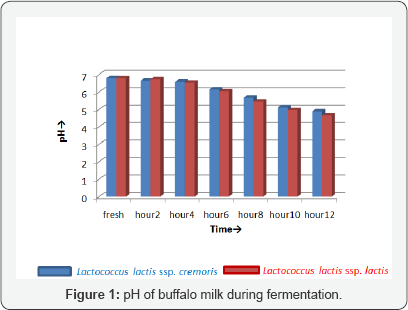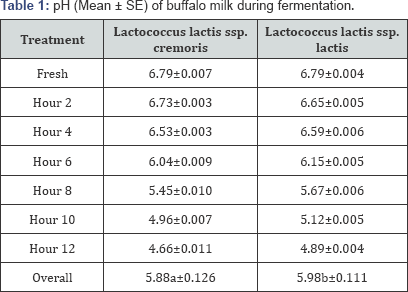Study on Proteolytic Potential of Buffalo Milk Using Lactococcus Lactis Ssp. Cremoris and Lactococcus Lactis Ssp. Lactis
Lokesh Tak1, Basant Bais1*, Raghvendar Singh2, C. S. Dhaka1 and Sanjay Singh1
1Department of Livestock Products Technology, College of Veterinary and Animal Science, India
2National Research Centre on Camel, India
Submission: July 19, 2017; Published: September 27, 2017
*Corresponding author: Basant Bais, Department of Livestock Products Technology, College of Veterinary and Animal Science, Rajasthan University of Veterinary and Animal Sciences, Bikaner- 334001, Rajasthan, India, Email: basantbais@gmail.com
How to cite this article: Lokesh T, Basant B, Raghvendar S, C. S. Dhaka, Sanjay S. Study on Proteolytic Potential of Buffalo Milk Using Lactococcus Lactis Ssp. Cremoris and Lactococcus Lactis Ssp. Lactis. Dairy and Vet Sci J. 2017; 3(5): 555625. DOI: 10.19080/JDVS.2017.03.555625
Abstract
The present investigation was designed to determine proteolytic potential of lactic acid bacteria (LAB) wiz. Lactococcus lactis ssp. cremoris and Lactococcus lactis ssp. Lactis at different time interval for a period of 12 hours. Study revealed that pH value and its rate of decrement was higher in samples, which are fermented with Lactococcus lactis ssp. cremoris comparing with Lactococcus lactis ssp. lactis, in buffalo milk samples.
Introduction
Buffalo milk contains all the nutrients in higher proportions than cow milk as per the nutrient components. The compositional differences between buffalo and cow milk are reflected on their physico-chemical properties. Milk from buffalo preferred for preparing dairy products of western and traditional (indigenous) type and nutritionally superior. Buffalo milk contains less cholesterol (total cholesterol 275 mg and free cholesterol 212mg per 100g of fat) in compared to cow milk (total cholesterol 330 mg and free cholesterol 280mg per 100g of fat) and more tocopherol (334.21|ig per kg for buffalo and 312.3|ig per kg of cow milk). Due to high peroxidase activity, buffalo milk can be preserved naturally for a longer period. Buffalo milk contains more calcium, better calcium: phosphorous ratio and less sodium and potassium than cow milk which makes it a better nutritional supplement for infants.
Due to growth requirements, dairy starter cultures have developed highly sophisticated proteolytic system that capable of break down milk proteins, mainly a1 and p-caseins. The proteolytic structure of lactic acid bacteria (LAB) and their activities in dairy products including yogurt and cheese have been studied extensively [1-5].
Lactococcus lactis has two subspecies with few phenotype and genotype differences, Lactococcus lactis ssp. lactis and ssp. cremoris, where subsp. lactis is preferred for making soft cheese while subsp. Cremoris is for hard cheese.
Materials and Methods
Periodical evaluation of fermented buffalo milk
Fresh buffalo milk was skimmed to bring the fat contents to below 0.5% using cream separator. The samples were heated to boil at least for 5min to inactivate/kill the inherent microbial population present in milk. Then Lactococcus lactis ssp. cremoris and Lactococcus lactis ssp. lactis cultures were inoculated @ 1% and after proper mixing, the samples were inoculated at 30 °C .The samples were drawn at 0, 2, 4, 6, 8, 10, 12 hours and were subjected to analysis for change in pH.
Bacterial cultures and their propagation
Glass ampoules containing Lyophilized powder of Lactococcus lactis ssp. cremoris NCDC 81 and Lactococcus lactis ssp. lactis NCDC 88 were obtained from the NCDC (National Collection of Dairy Cultures) Dairy Microbiology Division ICAR-National Dairy Research Institute, Karnal (INDIA). The organisms were stored at 4 °C. The propagation for each strain was performed according to Donker et al., [1] with slight modification. Sterile 5ml aliquots of reconstituted sterile skim milk (RSM) (Himedia Laboratories) were inoculated with each strain individually and incubated at 30 °C for 24h in BOD incubator. After incubation, the pre-inoculated cultures were prepared by transferring loop full of activated culture to 10ml aliquots of litmus milk (Himedia Laboratories) to determine the activation of culture activity by observing change in color of litmus milk after 24 hour of inoculation Figure 1. The skim milk and litmus milk were autoclaved following the standard procedure (121°C for 15min @15lbs).

pH measurement of milk samples:
The pH of samples was measured by using combined glass electrode of Milkoscan at camel milk research laboratory, ICAR- NRC on Camel, Bikaner.
Result and Discussion
Change in pH during hydrolysis:

Note - Means bearing different superscripts within a row differ significantly
The data related to pH of buffalo milk has been shown in Table 1 .The pH of fresh milk was found to be 6.79±0.004 for Lactococcus lactis ssp. cremoris and 6.79±0.007 for Lactococcus lactis ssp. lactis before inoculation of treated bacteria.
The value of pH was dropped significantly as the fermentation hour were increased and at 12 hour of fermentation and it was observed to be 4.89±0.004 and 4.66±0.011 for Lactococcus lactis ssp. cremoris and Lactococcus lactis ssp. lactis respectively whereas the overall pH was 5.98±0.111 and 5.88±0.126 for Lactococcus lactis ssp. cremoris and Lactococcus lactis ssp. lactis respectively. The pH value demonstrated in Table 1 reveals that the rate of decrement was higher in samples, which are fermented with Lactococcus lactis ssp. cremoris comparing with Lactococcus lactis ssp. lactis, in buffalo milk samples. [6,7].
Process of fermentation is affected by several factors including the structure of the protein, temperature, enzyme/ protein ratio, enzyme concentration and pH. In the present study, almost linear drop in pH was observed during the fermentation process in buffalo milk samples. The release of protons (H+ ion) and/or production of acidic amino acids into the surrounding medium results in reduction in the pH of the reaction mixture.

** = Significant at 1% (P<0.01).
The statistical analysis of data as shown in Table 2, revealed that there was a highly significant (P<0.01) decrease in the pH value of buffalo milk samples with advancement of fermentation hours as well as between the treated bacteria that is Lactococcus lactis ssp. cremoris and Lactococcus lactis ssp. lactis. [8,9].
References
- Shah NP, Ravula RR (2000) Micro encapsulation of probiotic bacteria and their survival in frozen fermented dairy desserts. Australian Journal of Dairy Technology 55(3): 139-144.
- Shalash MR (1979) Utilization of camel meat and milk in human nourishment. Provisional Report, International Foundation for Science 6: pp.285-306.
- Hernandez D, Cardell E, Zarate V (2005) Antimicrobial activity of lactic acid bacteria isolated from Tenerife cheese: initial characterization of plantaricin TF711, a bacteriocin-like substance produced by Lactobacillus plantarum TF711. J Appl Micro 99(1): 77-84.
- Lourens HA, Viljoen BC (2001) Yogurt as probiotic carrier food. Int dairy j 11(1): 1-17.
- Donkor ON, Henriksson A, Vasiljevic T, Shah NP (2007) Proteolytic activity of dairy lactic acid bacteria and probiotics as determinant of growth and in vitro angiotensin-converting enzyme inhibitory activity in fermented milk. Lait 86: 21-38.
- Rao MB, Gupta RC, Dastur NN (1970) Camels' milk and milk products. Ind J Dairy Sci 23: 71-78.
- Minieri L, De Franciscis G, Intrieri F (1965) On behavior of pH value in relation to acidity and chemical constituents of milk: research in Bubalus buffalus. Acta Med Vet (Napoli) 11(1): 107-114.
- Pan D, Luo Y, Tanokura M (2005) Antihypertensive peptides from skimmed milk hydrolysate digested by cell-free extract of Lactobacillus helveticus JCM1004. Food Chemistry 91(1): 123-129.
- Gomes AMP, Malcata FX (1999) Bifidobacterium spp. and Lactobacillus acidophilus: biological, biochemical, technological and therapeutically properties relevant for use as probiotics. Trends in Food Science & Technology 10: 139-157.






























